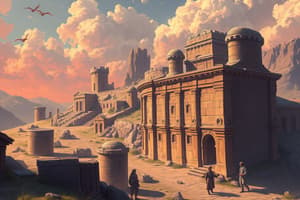Podcast
Questions and Answers
What role do artifacts play in understanding commercial exchange and trade?
What role do artifacts play in understanding commercial exchange and trade?
- They are irrelevant to historical research.
- They only reflect the aesthetic values of a culture.
- They provide direct records of historical events.
- They indicate patterns of commercial exchange and trade. (correct)
What type of evidence do folk songs and tales provide in historical research?
What type of evidence do folk songs and tales provide in historical research?
- Oral evidence with historical context (correct)
- Visual representation of events
- Comparative analysis with modern cultures
- Scientific data on past demographics
Which type of source is classified as a primary source?
Which type of source is classified as a primary source?
- Newspaper articles reporting on events at the time (correct)
- Biographies written years after the events
- Documentaries discussing past cultures
- Textbooks analyzing historical events
What is typically discovered inadvertently during construction projects?
What is typically discovered inadvertently during construction projects?
Which of the following is a characteristic of secondary sources?
Which of the following is a characteristic of secondary sources?
What is the main purpose of primary sources in historical research?
What is the main purpose of primary sources in historical research?
How can visual representations aid historical research?
How can visual representations aid historical research?
Which of the following statements about archaeological discoveries is true?
Which of the following statements about archaeological discoveries is true?
What is the primary goal of historians in reconstructing history?
What is the primary goal of historians in reconstructing history?
Which method do historians NOT typically use in their research?
Which method do historians NOT typically use in their research?
What does historiography refer to in the context of historical study?
What does historiography refer to in the context of historical study?
Why is the study of history considered subjective compared to natural sciences?
Why is the study of history considered subjective compared to natural sciences?
In their work, historians often draw inferences to fill gaps in knowledge. What might limit these inferences?
In their work, historians often draw inferences to fill gaps in knowledge. What might limit these inferences?
Which aspect is crucial for historians when analyzing historical records?
Which aspect is crucial for historians when analyzing historical records?
How does the work of historians differ from that of geologists and paleozoologists?
How does the work of historians differ from that of geologists and paleozoologists?
What is a challenge historians face in their reconstruction of the past?
What is a challenge historians face in their reconstruction of the past?
What defines secondary sources in historical research?
What defines secondary sources in historical research?
What is the primary aim of historical criticism?
What is the primary aim of historical criticism?
Which of the following is NOT a component of historical criticism?
Which of the following is NOT a component of historical criticism?
What is meant by external criticism in historical analysis?
What is meant by external criticism in historical analysis?
How did the emergence of historical criticism relate to the Protestant Reformation?
How did the emergence of historical criticism relate to the Protestant Reformation?
What kind of writings are characterized as secondary sources?
What kind of writings are characterized as secondary sources?
Which of the following is a methodology associated with historical criticism?
Which of the following is a methodology associated with historical criticism?
Which aspect of historical criticism focuses on the reliability of testimonies?
Which aspect of historical criticism focuses on the reliability of testimonies?
What is the primary focus of internal criticism in historical analysis?
What is the primary focus of internal criticism in historical analysis?
Which of the following techniques is NOT used in establishing the authenticity of a source?
Which of the following techniques is NOT used in establishing the authenticity of a source?
What is a crucial factor when applying paleographical criticism?
What is a crucial factor when applying paleographical criticism?
How do historians verify the authenticity of a document?
How do historians verify the authenticity of a document?
What aspect is NOT typically considered when evaluating the historical accuracy of a document's facts?
What aspect is NOT typically considered when evaluating the historical accuracy of a document's facts?
Why is it important to examine historical documents from multiple perspectives?
Why is it important to examine historical documents from multiple perspectives?
What was notably scarce in Europe before the fifteenth century, influencing document authentication?
What was notably scarce in Europe before the fifteenth century, influencing document authentication?
Which of the following best summarizes the purpose of internal criticism?
Which of the following best summarizes the purpose of internal criticism?
What is the role of isographies in historical document examination?
What is the role of isographies in historical document examination?
Which technique was systematized by Mabillon in the seventeenth century?
Which technique was systematized by Mabillon in the seventeenth century?
What can spelling inconsistencies in signatures reveal?
What can spelling inconsistencies in signatures reveal?
Which of the following is NOT a method used to establish the authenticity of historical documents?
Which of the following is NOT a method used to establish the authenticity of historical documents?
How does the provenance of a document affect its presumed authenticity?
How does the provenance of a document affect its presumed authenticity?
What is the focus of sigillography in the context of historical documents?
What is the focus of sigillography in the context of historical documents?
What can be a sign of forgery when analyzing historical documents?
What can be a sign of forgery when analyzing historical documents?
Which of these factors is considered when determining the potential author of a historical document?
Which of these factors is considered when determining the potential author of a historical document?
Flashcards are hidden until you start studying
Study Notes
Understanding History
- Historians rely on available records and inferences to reconstruct the past.
- They interpret surviving evidence, considering setting, motivations, and actions of historical actors.
- They use broader historical knowledge to fill gaps in direct evidence.
- History encompasses only what can be pieced together using available records and inferences.
- Historians strive for verisimilitude – a believable and accurate understanding of the past.
- History is subjective, unlike natural sciences.
Historical Method and Historiography
- Historical technique involves analyzing historical documents and artifacts.
- Historiography is the creative reconstruction of the past based on gathered information.
- Historians use historical technique and historiography to reconstruct the past.
- They rarely describe events exactly as they happened, emphasizing the limitations of available records.
- Artifacts reveal patterns of trade and exchange.
- Garbage pits can provide traces of past settlements.
- Archaeological evidence helps historians reconstruct and understand the past.
- Archaeological sites are sometimes discovered during construction projects.
- Archaeological discoveries, like coins, provide insights into governmental transactions.
- Visual depictions, like drawings, etchings, paintings, films, and photographs, offer insights into historical events.
- Oral evidence, like folk songs, sagas, and tales, provides context in premodern history.
- Interviews are becoming vital sources of oral evidence in modern history.
Primary vs. Secondary Sources
- Primary sources are firsthand accounts created during or shortly after the event.
- They provide direct, factual information without interpretation.
- Examples include diaries, journals, letters, government records, photographs, maps, speeches, interviews, songs, paintings, and sculptures.
- Secondary sources are created by individuals who lived long after the events they describe.
- They offer interpretations and analyses based on primary sources.
- Examples include biographies, historical writings, literary criticism, book reviews, art reviews, and interpretive news articles.
Historical Criticism
- Historical criticism aims to understand the text's original meaning and its historical context.
- External criticism focuses on determining the authenticity of a source using diplomatic critique and paleographical criticism.
- Internal criticism evaluates the reliability of testimonies and assesses their truthfulness.
- Historical criticism emerged during the 17th century, gaining significance in the 19th and 20th centuries.
- It has evolved and diversified with source criticism, form criticism, redaction criticism, tradition criticism, and canonical criticism.
External Criticism
- It focuses on determining a source's authenticity by investigating origin, authorship, and information sources.
- Techniques include diplomatic critique (assessing the source's external form) and paleographical criticism (studying writing, script, and language to assess alterations).
- Forgery is considered during this process, especially for sources from the Middle Ages.
Internal Criticism
- It evaluates the historical accuracy of the facts presented in a document.
- It aims to establish the reliability of the testimony and determine if the facts are accurate.
- Factors considered include the credibility of sources, the author's knowledge, and prevailing influences.
- It requires a precise understanding of what the author conveyed and their perspective during the writing.
Test of Authenticity
- Historians use various tests to distinguish between authentic and fraudulent documents.
- They analyze the materials used, considering their consistency with the time period.
- They examine the inks used, looking for anachronistic elements.
- They identify the possible author through handwriting, signatures, seals, and watermarks.
- They use techniques like paleography and diplomatics to identify conventionalized handwriting styles and forms.
- They study seals using sigillography to identify fraudulent ones.
- They examine language, idioms, orthography, and punctuation for anachronisms.
- They analyze spelling, especially of proper names and signatures, for signs of forgery.
- They look for anachronistic references to events or dates.
- They consider the document's provenance, as its expected location adds credibility.
- They investigate for potential copying from known historical sources, looking for inconsistencies or unfamiliar information.
Studying That Suits You
Use AI to generate personalized quizzes and flashcards to suit your learning preferences.




